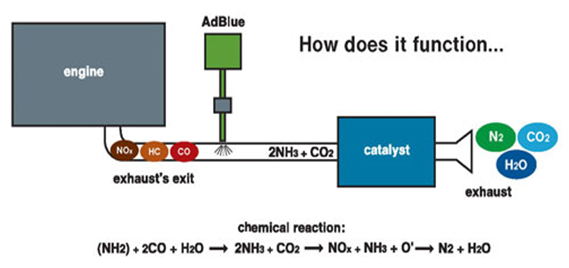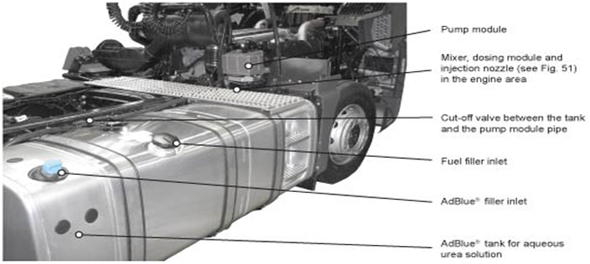What is AdBlue?
Ad-Blue is a solution of urea in demineralised water (32,5%) used as an fluid in the latest generation of diesel-powered Euro4 & Euro5 trucks. It is a common misconception that Ad-Blue is a fuel additive.
Ad-Blue is contained in a separate tank to the fuel and is sprayed into the exhaust gases. Therefore, it is never mixed or added to the fuel. Ad-Blue is not a fuel additive. It is an exhaust treatment chemical.
How does Ad-Blue Work?
Ad-Blue is stored in a separate tank on the vehicle. It is precisely metered and sprayed into the hot exhaust manifold where the urea solution breaks-down into ammonia and reacts with the exhaust gasses in the presence of a catalytic converter.
The oxides of nitrogen formed at combustion are converted into harmless elementary nitrogen and water. This method is called Selective Catalytic Reduction (SCR). The usage of Ad-Blue lies at 3 to 5% of the diesel usage.

How will Ad-Blue affect me?
All trucks & buses registered after October 2006 must be at least Euro4 compliant and most will require Ad-Blue. It will not normally be possible to retrofit Ad-Blue equipment to existing vehicles so only new vehicles will be affected.
In practical terms a fleet with 6 Euro4 vehicles will need about 1,000 litres per month of Ad-Blue. As vehicles will typically be fitted with a 70 or 90 litre Ad-Blue tank, most vehicles will need to be topped-up with Ad-Blue every week-to-ten-day.
How much will I need?
On Euro4 vehicles, Ad-Blue consumption will be about 3-5% of diesel use, so a typical truck will use between 1500-2500 litres of Ad-Blue per year depending on engine size and mileage. This is about 30-40 litres per week per truck.
For a Euro 5 engine the Ad-Blue consumption will be higher than Euro4 at 5-6% of diesel, depending on driving, load and road conditions
What are the relevant EU Regulations?
European Union emission regulations for new light duty vehicles (cars and light commercial vehicles) are specified in the Directive 70/220/EEC. This basis Directive was amended a number of times, some of the most important amendments including:
• Euro 1 standards (also known as EC 93): Directives 91/441/EEC (passenger cars only) or 93/59/EEC (passenger cars and light trucks)
• Euro 2 standards (EC 96): Directives 94/12/EC or 96/69/EC
• Euro 3/4 standards (2000/2005): Directive 98/69/EC, further amendments in 2002/80/EC
• Euro 5 standards (2008): Proposed regulation [COM(2005) 683] published in December 2005
EURO III is the emission standard for vehicles introduced in the EU in 1999. It limits diesel car emissions to 0.5 g/km of NOx and 0.05 g/km of Particulate Matter (PM), petrol cars to 0.15 g/km NOx and Heavy Goods Vehicles (HGVs) to 5 g/kWh of NOx and 0.1 g/kWh of PM.
EURO IV is the emission standard for vehicles that will be introduced in the EU in 2005 and come into force in 2006. It limits diesel car emissions to 0.25 g/km of NOx and 0.025 g/km of Particulate Matter (PM), petrol cars to 0.08 g/km NOx and Heavy Goods Vehicles (HGVs) to 3.5 g/kWh of NOx and 0.02 g/kWh of PM. It will be replaced by Euro V, to be introduced in 2008 and coming into force in 2009.
EURO V is a European emission standard for vehicles that will be introduced in the EU in 2009. It proposes to limit diesel car emissions to 0.2 g/km of NOx and 0.005 g/km of Particulate Matter (PM), petrol cars to 0.06 g/km NOx and Heavy Goods Vehicles (HGVs) to 2.0 g/kWh of NOx and 0.02 g/kWh of PM.
The price may rise or fall depending on energy prices, delivery location and, for product packaged in exchangeable IBC's, 210 litre drums, additional packaging and delivery premiums may apply.
What equipment will I need?
Most operators will dispense Ad-Blue from a 1000 litre IBC container or from a 5000 litre bulk storage tank in their yard.
When using IBCs, a special Ad-Blue-grade pump and bund will be required and an additional IBC may be required so that when the first IBC runs-out, a second is available straight-away. You must avoid aluminium, brass or mild-steel fittings, even if nickel plated. Stainless Steel and plastic equipment with special seals must be used in all Ad-Blue installations.

What happens if I run out on the road?
Your vehicle's tank will normally contain up to two weeks supply of Ad-Blue and, provided the tank is topped up at the depot weekly, drivers will not normally need to fill-up on the road.
Drivers may want to carry a small 10 litre plastic container of Ad-Blue on the vehicle in case they run-out... enough for about 400 miles of driving.
For trucks registered after October 2007 an on-board-diagnostics vehicle sensor will ensure that genuine Ad-Blue is present in the special tank. If Ad-Blue runs-dry, the Engine Management System will progressively and gradually reduce engine power by 50% to a limp-home mode over the space of 100 Km distance.
Can I use Ad-Blue with BioDiesel?
Biodiesel and SCR are compatible even if 100% Biodiesel is used. Of course all special material demands on the engine running with biodiesel have to be considered for the complete SCR-equipment on the truck. That means that the truck operator needs a confirmation of the truck producer for the use of biodiesel on a certain truck.
When using biodiesel the exhaust gas contains more NOx and the Ad-Blue consumption of the SCR equipment will be slightly higher if used at 100% biodiesel.
Is Ad-Blue corrosive?
Ad-Blue is non-toxic and poses no serious risk to humans, animals or the environment if properly handled.
The product is slightly alkaline with a pH of approx 9.0 so should not be kept in contact with aluminium, brass, mild steel. Stainless Steel and Plastic tanks and fittings are recommended. Prolonged skin contact may cause irritation. CEFIC guidance available at www.petrochemistry.net [Automotive Grade Urea Group] provides the latest guidance.
So how can Polaris Distribution Ltd help with your Ad-Blue needs?
Polaris Distribution Ltd provides you with the highest reliability in Ad-Blue quality and distribution at very competitive rates.